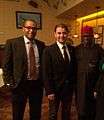Peace River—Westlock
 Peace River—Westlock in relation to other Alberta federal electoral districts as of the 2013 Representation Order. | |||
| Federal electoral district | |||
| Legislature | House of Commons | ||
| MP |
| ||
| District created | 2013 | ||
| First contested | 2015 | ||
| District webpage | profile, map | ||
| Demographics | |||
| Population (2011)[1] | 108,095 | ||
| Electors (2015) | 75,362 | ||
| Area (km²)[2] | 105,095 | ||
| Pop. density (per km²) | 1 | ||
| Census divisions | Division No. 13, Division No. 17, Division No. 18, Division No. 19 | ||
| Census subdivisions | Barrhead, Barrhead No. 11, Big Lakes, Greenview No. 16, Mackenzie, Peace River, Slave Lake, Westlock, Westlock County, Whitecourt | ||
Peace River—Westlock is a federal electoral district in Alberta.
Peace River—Westlock was created by the 2012 federal electoral boundaries redistribution and was legally defined in the 2013 representation order.[3] It came into effect upon the call of the 42nd Canadian federal election, scheduled for October 19, 2015. [4] It was created out of parts of Peace River, Fort McMurray—Athabasca, Yellowhead, and Westlock—St. Paul.[5]
There is no incumbent candidate for this new riding, and all parties will have to hold nomination contests to select their candidates for MP.
Members of Parliament
This riding has elected the following members of the House of Commons of Canada:
| Parliament | Years | Member | Party | |
|---|---|---|---|---|
| Peace River—Westlock Riding created from Fort McMurray—Athabasca, Peace River Westlock—St. Paul, and Yellowhead |
||||
| 42nd | 2015–Present | Arnold Viersen | Conservative | |
Profile
This riding is a typical conservative stronghold riding. There are several ridings in Alberta that the Conservative Party of Canada realistically expects to win, and this is one of them. However, the northern portion of the riding is less strongly conservative than the rest, with pockets of support for the NDP. Historically, this riding has been always right-leaning, with support beginning toward the old Progressive Conservative Party of Canada, shifting toward the right-wing Reform Alliance Party after the time of prime minister Brian Mulroney, and then held by the new Conservative Party of Canada since the unification of the Progressive Conservatives and Canadian Alliance in 2003.
Election results
| Canadian federal election, 2015 | ||||||||
|---|---|---|---|---|---|---|---|---|
| Party | Candidate | Votes | % | ∆% | Expenditures | |||
| Conservative | Arnold Viersen | 34,342 | 69.35 | -8.46 | – | |||
| New Democratic | Cameron Alexis | 7,127 | 14.39 | +1.35 | – | |||
| Liberal | Chris Brown | 6,360 | 12.84 | +9.20 | – | |||
| Green | Sabrina Lee Levac | 1,247 | 2.52 | -1.34 | – | |||
| Libertarian | Jeremy Sergeew | 443 | 0.89 | – | – | |||
| Total valid votes/Expense limit | 49,519 | 100.00 | $257,907.25 | |||||
| Total rejected ballots | 170 | 0.34 | – | |||||
| Turnout | 49,689 | 65.93 | – | |||||
| Eligible voters | 75,362 | |||||||
| Conservative hold | Swing | -4.90 | ||||||
| Source: Elections Canada[6][7] | ||||||||
| 2011 federal election redistributed results[8] | |||
|---|---|---|---|
| Party | Vote | % | |
| Conservative | 28,986 | 77.81 | |
| New Democratic | 4,859 | 21.10 | |
| Green | 1,436 | 3.85 | |
| Liberal | 1,357 | 3.64 | |
| Others | 616 | 1.65 | |
2015 nomination contests
NDP
- Announced Candidates:
- Cameron Alexis (winner)
Conservative Party of Canada (Votes took place July 6th - 8th 2015)
- Announced Candidates:
 Terry Hogan
Terry Hogan Jackie Larsen
Jackie Larsen Eris Moncur
Eris Moncur Arnold Viersen
Arnold Viersen
Liberal Party: Christopher Brown, Communications Coordinator for the Town of Slave Lake.
Green Party (none announced) Christian Heritage Party of Canada (none announced)
References
- ↑ Stastistics Canada: 2011
- ↑ Stastistics Canada: 2011
- ↑ District Description
- ↑ Timeline for the Redistribution of Federal Electoral Districts
- ↑ Report – Alberta
- ↑ "October 19, 2015 Election Results — Peace River—Westlock (Validated results)". Elections Canada. 24 October 2015. Retrieved 4 November 2015.
- ↑ Elections Canada – Preliminary Election Expenses Limits for Candidates
- ↑ Pundits' Guide to Canadian Elections
- ↑ Terry Hogan
- ↑ AM610 Newsroom - Peace River, Alberta
- 1 2 AM610 Newsroom - Peace River, Alberta